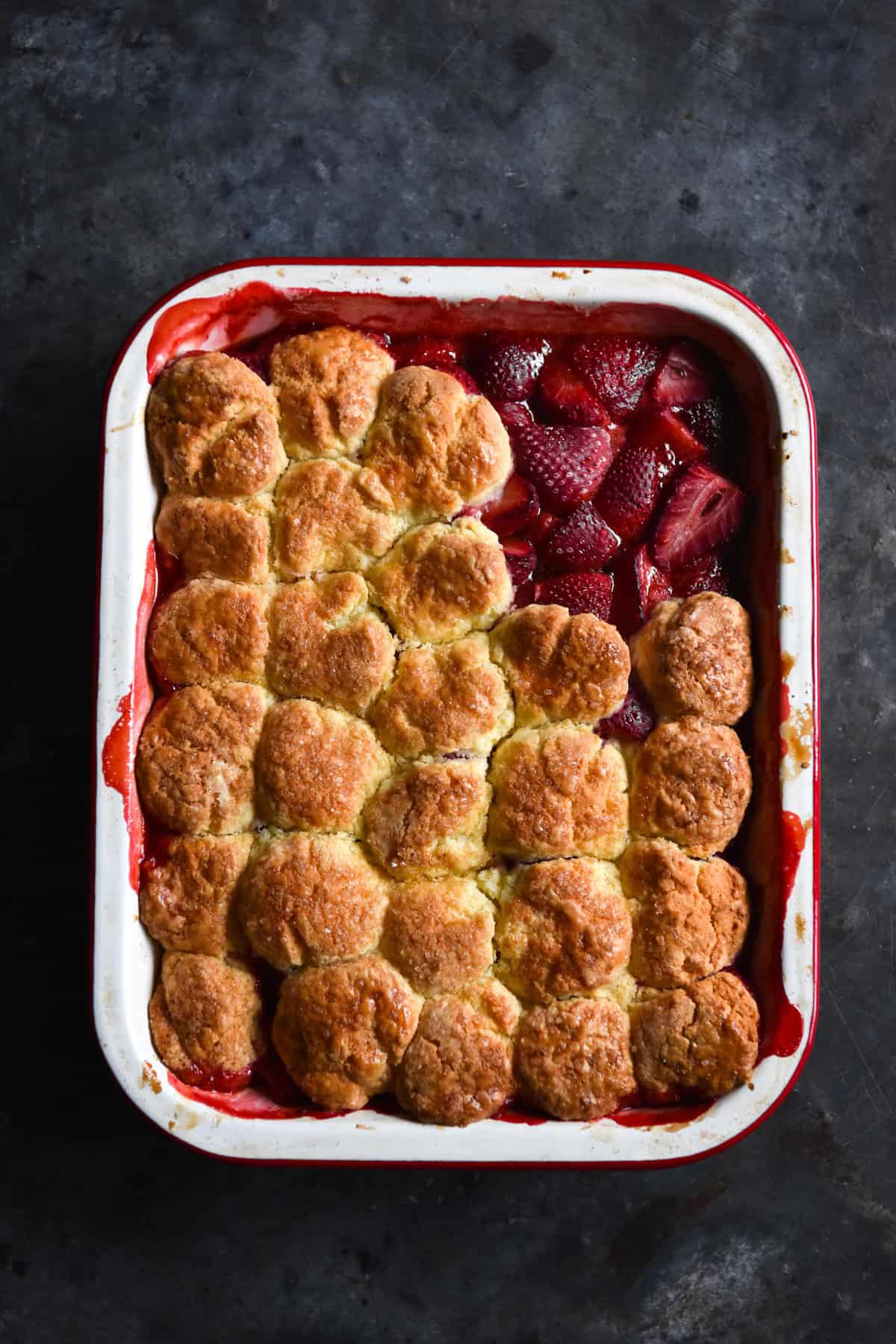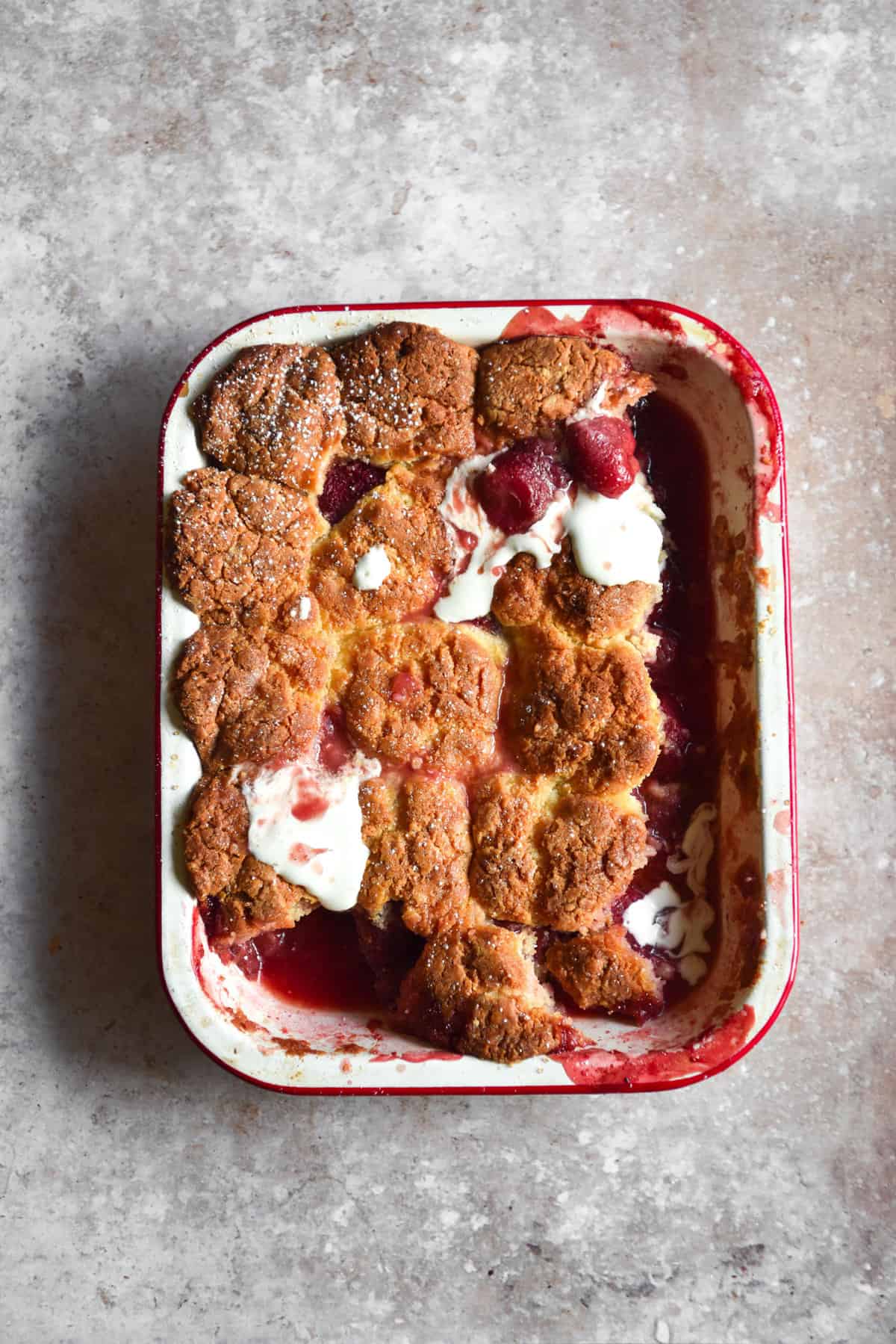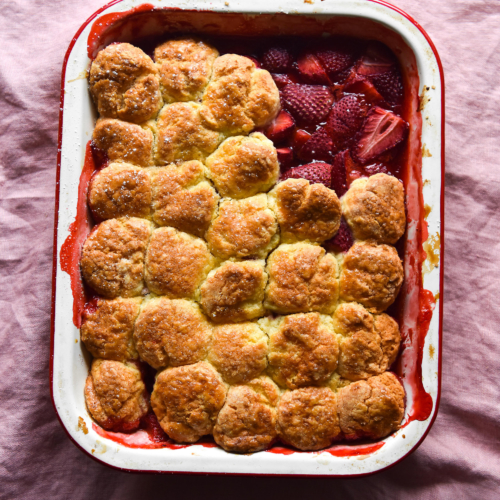
This gluten free strawberry cobbler was my first hint of a successful gluten free scone recipe. I had failed at gluten free scones for years, but the ratios for this cobbler gave me a hint. So, you can thank this gluten free cobbler for my gluten free scone and gluten free sweet biscuit recipes. You can also thank this recipe for my gluten free blueberry cobbler recipe.
Gluten free strawberry cobbler
You might have noticed that I keep using the word scone in a cobbler recipe. Because I am not from America and feel very uncomfortable calling a scone a biscuit (sorry, it’s a scone) I’m sticking with my native terminology. That, and I also worked on the recipe as if I were working on a scone recipe. Two birds, one stone/scone, you know.
This gluten free strawberry cobbler is gluten free (obviously!) low in lactose and FODMAP friendly. It uses simple gluten free pantry flours (white rice flour and tapioca flour) and a simple technique to create a delicious dessert that can be enjoyed year round.

Gluten free cobbler FODMAP notes
Firstly, let’s chat fruit. Monash have recently introduced a threshold for strawberries, which is rude. They used to be ‘eat according to appetite’ whereas now a FODMAP friendly serving is 65g. If you have previously eaten large quantities strawberries with no issues, then you don’t need to change anything. If they have given you issues, I recommend using 500g of strawberries and 500g of rhubarb in this cobbler. You may need to add a little extra sugar to the fruit mixture to compensate for the tartness of the rhubarb.
Secondly, let’s chat scones (or biscuits.) The topping here makes use of butter (very low in lactose) lactose free cream, and an egg. An egg isn’t traditional in a scone or biscuit, but because they are gluten free it provides some elasticity and binding. They’re probably not as flaky as a traditional one, but they’re also not bone dry or packed with gums, so there’s that.
The biscuity bits use a simple combination of equal parts finely milled white rice flour and tapioca flour. I know the lack of cup measures can be annoying, but the precision is so necessary in gluten free baking. I tried one batch with more tapioca than rice flour and the bottoms became a soggy mess. Another batch was attempted with inverse measurements, and they were too gritty. This really is the perfect level.

Where to buy good quality gluten free flours
A quick note on buying flours. I highly recommend going to a bulk food store to purchase these flours, if you have access to one. Not only are the packaging free, but they’re generally more finely milled, and thus less gritty, than the variety at the supermarket. This is especially important for the rice flour, which can make or break a gluten free baked good.
Recipe substitutions for your gluten free strawberry cobbler
As I have mentioned previously, frozen fruit is a great option when you’re making this cobbler in winter. I would recommend thawing the berries off a little first, because otherwise the cornflour has a tricky time mixing in, and there is extra liquid in the dish. Add a little extra cornflour for frozen fruit, to absorb some of that extra liquid.
In terms of using a different fruit, you don’t have too many other berry options for a FODMAP friendly version. If you don’t need it to be fructose friendly, you can obviously use whatever you want, but some of us don’t have that luxury. Check out the Monash app for a list of FODMAP maximum quantities if you’d like to use a different fruit, and just make sure not too eat too much cobbler.
I have not tried this recipe with a butter substitute, or with a cream substitute. I’d love to hear about it if you do and it works!

FODMAP update
Monash have recently introduced a threshold for strawberries, which is !rude! They used to be ‘eat according to appetite’ whereas now a FODMAP friendly serving is 65g. If you have previously eaten large quantities strawberries with no issues, then you don’t need to change anything. If they have given you issues, I recommend using 500g of strawberries and 500g of rhubarb in this cobbler. You may need to add a little extra sugar to the fruit mixture to compensate for the tartness of the rhubarb.
More fruit based gluten free recipes
- My gluten free fruit crumble
- Not quite fruit, but this zucchini ‘apple’ crumble
- Vegan, gluten free and xanthan gum free blueberry muffins
- And a classic blueberry muffin
- Gluten free blueberry scones

Gluten free strawberry cobbler (FODMAP friendly)
Equipment
- Scone cutter in size of your choice (I tested with both a 4cm and 5cm circumference cutter) and a 28cm x 22cm baking dish (4cm depth)
Ingredients
For the strawberries:
- 1 kg strawberries
- Juice of 1 lemon
- 2-3 tablespoons caster sugar
- 1 tablespoon orange blossom water (optional)
- 1-2 tablespoons gluten free cornflour (this absorbs some of the moisture in the berries – use less for fresh and more for frozen berries)
- Pinch of sea salt flakes
For the topping:
- 120 g tapioca flour
- 120 g finely milled white rice flour
- 2 teaspoons baking powder
- 1/4 cup caster sugar
- 100 g butter (salted or unsalted but cold – straight from the fridge)
- 1 extra large egg (whisked well)
- 1/2 cup + 1 tablespoon full fat lactose free cream
- Pinch of fine salt
- Extra tapioca flour, to flour the work surface
- Extra egg, for egg wash
Instructions
- Line a large baking tray with baking paper and set aside. In a large bowl, combine the flours, baking powder and sugar. Stir them well to combine.
- Cut the butter into small cubes, and add it to the flour mixture. Rub the butter pieces between your thumb and forefinger, so that they become like little fine sheets of butter. This encourages the dough to lift. Keep going until the mixture looks a little sandy. There should be no huge chunks of butter, but it shouldn’t be entirely gone. Little sheets are what we’re after. If it’s summer and your butter starts melting, just pop the mixture in the fridge for 5-10 minutes.
- Once the butter has been rubbed in, add the whisked egg, and use a spoon to gently incorporate it.
- Add the cream, 1/4 cup at a time. Gently push the mixture around the combine, without being too rough or flattening in the pieces of butter. The dough should be shaggy, but all the loose bits of flour should be wet or attached to the main ball of dough. You might not need the last tablespoon of cream, but see how you go.
- Gather the dough gently into a ball, and flour a clean, dry surface with tapioca flour. Place the dough onto the surface, and gently create a rectangle of dough, about 3 centrimetres thick. Keep moving the dough and making sure it isn’t sticking. Add tapioca flour whenever necessary.
- Preheat the oven to 200 degrees Celsius, or 392 Fahrenheit.
- Use your scone cutter to cut out the cobbler bits, flouring it liberally and whenever necessary. Place the cut scones onto the lined baking tray, and continue until you have used all the dough. Depending on the size of your cutter, you should have 18-24 little scone bits. I like to place them in the freezer for a little while to set the butter and encourage lift in the oven, but the fridge is fine too.
- Once the scones are in the fridge, de-hull your strawberries and place them in a large bowl. I like to leave some whole and chop the others for a bit of textural interest. Sprinkle the sugar and salt into the bowl and massage it in. The berries should start releasing juices straight away. After a couple of minutes, add the lemon juice and orange blossom water. Orange blossom is entirely optional – you could also use rosewater, vanilla, or just leave them plain. Stir to combine before adding the cornflour, tossing again until everything is incorporated.
- Transfer the berries and all their juices to the baking dish, and smooth them out as best you can. Remove the scones from the fridge/freezer, and give each a brush of well whisked egg wash before arranging in the tray. Arrange them close together – a tight knit pattern encourages them to expand upwards in the oven, rather than outwards.
- Give the topping a sprinkle of crunchy sugar, and place the tray in the oven. It’s good practice to put a large baking tray underneath oven cooked fruit – they have a tendency to become juicy and run all over your oven floor. Cook the cobbler for 10 minutes at 200, before reducing the heat to 180 Celsius (356 Fahrenheiand cooking for an additional 20 or so minutes.
- You can serve warm or cool – the juice will firm up as it cools. Don’t serve immediately as cooked fruit can be scalding hot. You can serve the cobbler with the remainder of the cream (ideally whipped with a tiny bit of icing sugaor vanilla ice cream.

So good and so easy! My son commented twice on how good they were. Will make again! Thank you!!
I made this last week and it was delicious! So easy but full of flavor.